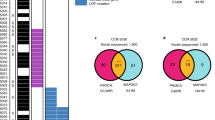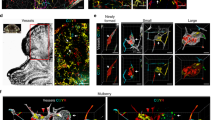Abstract
The past few years have seen rapid advances in our understanding of the genetics and molecular biology of cerebral cavernous malformations (CCM). This article summarizes the recent cloning of the CCM1, CCM2, and CCM3 genes, which are responsible for autosomal dominant CCM, and also describes current hypotheses for their roles in integrin and p38 mitogen-activated protein kinase-mediated regulation of angiogenesis. A mouse model of CCM has been generated by mutation of the Ccm1 gene, and it indicates a role for that protein in arterial development. Future studies will probably focus on integration of data from each of the three CCM genes into a single model of the pathogenesis of cavernous malformation.
Similar content being viewed by others
References and Recommended Reading
Moriarity JL, Clatterbuck RE, Rigamonti D: The natural history of cavernous malformations. Neurosurg Clin North Am 1999, 10:411–417.
Zabramski JM, Henn JS, Coons S: Pathology of cerebral vascular malformations. Neurosurg Clin North Am 1999, 10:395–410.
Wong JH, Awad IA, Kim JH: Ultrastructural pathological features of cerebrovascular malformations: a preliminary report. Neurosurgery 2000, 46:1454–1459.
Clatterbuck RE, Eberhart CG, Crain BJ, Rigamonti D: Ultrastructural and immunocytochemical evidence that an incompetent blood-brain barrier is related to the pathophysiology of cavernous malformations. J Neurol Neurosurg Psychiatry 2001, 71:188–192.
Marchuk DA, Gallione CJ, Morrison LA, et al.: A locus for cerebral cavernous malformations maps to chromosome 7q in two families. Genomics 1995, 28:311–314.
Gunel M, Awad IA, Anson J, Lifton RP: Mapping a gene causing cerebral cavernous malformation to 7q11.2-q21. Proc Natl Acad Sci U S A 1995, 92:6620–6624.
Dubovsky J, Zabramski JM, Kurth J, et al.: A gene responsible for cavernous malformations of the brain maps to chromosome 7q. Hum Mol Genet 1995, 4:453–458.
Craig H, Gunel M, Cepeda O, et al.: Multilocus linkage identifies two new loci for a mendelian form of stroke, cerebral cavernous malformation, at 7p15-13 and 3q25.2-27. Hum Mol Genet 1998, 7:1851–1858.
Johnson EW, Iyer LM, Rich SS, et al.: Refined localization of the cerebral cavernous malformation gene (CCM1) to a 4-cM interval of chromosome 7q contained in a well-defined YAC contig. Genome Res 1995, 5:368–380.
Gunel M, Awad IA, Finberg K, et al.: A founder mutation as a cause of cerebral cavernous malformation in Hispanic Americans. N Engl J Med 1996, 334:946–951.
Verlaan DJ, Laurent SB, Rochefort DL, et al.: CCM2 mutations account for 13% of cases in a large collection of kindreds with hereditary cavernous malformations. Ann Neurol 2004, 55:757–758.
Laberge-le Couteulx S, Jung HH, Labauge P, et al.: Truncating mutations in CCM1, encoding KRIT1, cause hereditary cavernous angiomas. Nat Genet 1999, 23:189–193.
Sahoo T, Johnson EW, Thomas JW, et al.: Mutations in the gene encoding KRIT1, a Krev-1/rap1a binding protein, cause cerebral cavernous malformations (CCM1). Hum Mol Genet 1999, 8:2325–2333.
Liquori CL, Berg MJ, Siegel AM, et al.: Mutations in a gene encoding a novel protein containing a phosphotyrosinebinding domain cause type 2 cerebral cavernous malformations. Am J Hum Genet 2003, 73:1459–1464. The first of two papers describing identification of the CCM2 gene. The authors used a candidate gene approach to find CCM2.
Denier C, Goutagny S, Labauge P, et al.: Mutations within the MGC4607 gene cause cerebral cavernous malformations. Am J Hum Genet 2004, 74:326–337. The second of two papers describing identification of CCM2. This paper also contains a description of the only bona-fide missense mutation (that does not also affect mRNA splicing) that has been found in a CCM family to date.
Bergametti F, Denier C, Labauge P, et al.: Mutations within the Programmed Cell Death 10 gene cause cerebral cavernous malformations. Am J Hum Genet 2005, 76:42–51. This paper describes the identification of the CCM3 gene by analysis of a deletion spanning the CCM3 locus.
Labauge P, Laberge S, Brunereau L, et al.: Hereditary cerebral cavernous angiomas: clinical and genetic features in 57 French families. Lancet 1998, 352:1892–1897.
Verlaan DJ, Laurent SB, Sure U, et al.: CCM1 mutation screen of sporadic cases with cerebral cavernous malformations. Neurology 2004, 62:1213–1215.
Verlaan DJ, Laurent SB, Rouleau GA, Siegel AM: No CCM2 mutations in a cohort of 31 sporadic cases. Neurology 2004, 63:1979.
Reich P, Winkler J, Straube A, et al.: Molecular genetic investigations in the CCM1 gene in sporadic cerebral cavernomas. Neurology 2003, 60:1135–1138.
Verlaan DJ, Siegel AM, Rouleau GA: Krit1 missense mutations lead to splicing errors in cerebral cavernous malformation. Am J Hum Genet 2002, 70:1564–1567.
Knudson AG: Mutation and cancer: statistical study of retinoblastoma. Proc Natl Acad Sci U S A 1971, 68:820–823.
Marini V, Ferrera L, Pigatto F, et al.: Search for loss of heterozygosity and mutation analysis of KRIT1 gene in CCM patients. Am J Hum Genet 2004, 130:98–101.
Gault J, Shenkar R, Recksiek P, Awad IA: Biallelic somatic and germ line CCM1 truncating mutations in a cerebral cavernous malformation lesion. Stroke 2005, 36:872–874. The first description of somatic mutation of the wild-type allele in a Ccm1 heterozygote. This paper may be confirmation of the two-hit hypothesis, and its importance is limited only by the fact that the data are derived from a single cavernous malformation.
Zhang J, Clatterbuck RE, Rigamonti D, Dietz HC: Cloning of the murine Krit1 cDNA reveals novel mammalian 5′ coding exons. Genomics 2000, 70:392–3955.
Sahoo T, Goenaga-Diaz E, Serebriiskii IG, et al.: Computational and experimental analyses reveal previously undetected coding exons of the KRIT1 (CCM1) gene. Genomics 2001, 71:123–126.
Eerola I, McIntyre B, Vikkula M: Identification of eight novel 5′-exons in cerebral capillary malformation gene-1 (CCM1) encoding KRIT1. Biochim Biophys Acta 2001, 1517:464–467.
Serebriiskii IG, Estojak J, Sonoda G, et al.: Association of Krev-1/rap1a with Krit1-1, a novel ankyrin repeat-containing protein encoded by a gene mapping to 7q21-22. Oncogene 1997, 15:1043–1049.
Zhang J, Clatterbuck RE, Rigamonti D, et al.: Interaction between krit1 and icap1alpha infers perturbation of integrin beta1-mediated angiogenesis in the pathogenesis of cerebral cavernous malformation. Hum Mol Genet 2001, 10:2953–2960.
Zawistowski JS, Serebriiskii IG, Lee MF, et al.: KRIT1 association with the integrin-binding protein ICAP-1: a new direction in the elucidation of cerebral cavernous malformations (CCM1) pathogenesis. Hum Mol Genet 2002, 11:389–396.
Degani S, Balzac F, Brancaccio M, et al.: The integrin cytoplasmic domain-associated protein ICAP-1 binds and regulates Rho family GTPases during cell spreading. J Cell Biol 2002, 156:377–388.
Whitehead KJ, Plummer NW, Adams JA, et al.: Ccm1 is required for arterial morphogenesis: implications for the etiology of human cavernous malformations. Development 2004, 131:1437–1448. This paper is the first description of the Ccm1 knockout mouse, and it implicates Ccm1 in the regulation of arterial development. This is the first evidence that cavernous malformations may be derived from defective arteries.
Plummer NW, Gallione CJ, Srinivasan S, et al.: Loss of p53 sensitizes mice with a mutation in Ccm1 (KRIT1) to development of cerebral vascular malformations. Am J Pathol 2004, 165:1509–1518. Crossing the Ccm1 knockout mice with p53 knockout mice resulted in vascular lesions that are very similar to human CCMs. The data are consistent with the two-hit hypothesis (increased somatic mutation due to p53 mutation) but may also reflect a role for p53 in angiogenesis and/or CCM pathogenesis.
Shao C, Deng L, Henegariu O, et al.: Chromosome instability contributes to loss of heterozygosity in mice lacking p53. Proc Natl Acad Sci U S A 2000, 97:7405–7410.
Kehrer-Sawatzki H, Wilda M, Braun VM, et al.: Mutation and expression analysis of the KRIT1 gene associated with cerebral cavernous malformations (CCM1). Acta Neuropathol 2002, 104:231–240.
Denier C, Gasc JM, Chapon F, et al.: Krit1/cerebral cavernous malformation 1 mRNA is preferentially expressed in neurons and epithelial cells in embryo and adult. Mech Dev 2002, 117:363–367.
Faisst AM, Gruss P: Bodenin: a novel murine gene expressed in restricted areas of the brain. Dev Dynam 1998, 212:293–303.
Guzeloglu-Kayisli O, Amankulor NM, Voorhees J, et al.: KRIT1/ cerebral cavernous malformation 1 protein localizes to vascular endothelium, astrocytes, and pyramidal cells of the adult human cerebral cortex. Neurosurgery 2004, 54:943–949. Expression of CCM1 in astrocytes could explain the defective blood-brain barrier in cavernous malformations.
Abbott NJ: Astrocyte-endothelial interactions and bloodbrain barrier permeability. J Anatomy 2002, 200:629–638.
Uhlik MT, Abell AN, Johnson NL, et al.: Rac-MEKK3-MKK3 scaffolding for p38 MAPK activation during hyperosmotic shock. Nat Cell Biol 2003, 5:1104–1110. This paper describes the role of CCM2 in regulation of p38 MAPK activation, and it established fertile ground for further analysis of CCM1and CCM2 function.
Mudgett JS, Ding J, Guh-Siesel L, et al.: Essential role for p38alpha mitogen-activated protein kinase in placental angiogenesis. Proc Natl Acad Sci USA 2000, 97:10454–10459.
Yang J, Boerm M, McCarty M, et al.: Mekk3 is essential for early embryonic cardiovascular development. Nat Genet 2000, 24:309–313.
Zawistowski JS, Uhlik MT, Johnson JL, Marchuk DA: Interaction of the Cerebral Cavernous Malformations type 1 and type 2 gene products. American Society of Human Genetics, 54th Annual Meeting 2004. http://www.ashg.org/genetics/ ashg04s/index.shtml. Accessed on May 1, 2005.
Zhang J, Clatterbuck RE, Basu S, et al.: Pathogenesis of cerebral cavernous malformation: Depletion of Krit1 leads to perturbation of b1 integrin-mediated endothelial cell mobility and survival. American Society of Human Genetics, 54th Annual Meeting 2004. http://www.ashg.org/genetics/ashg04s/ index.shtml. Accessed on May 1, 2005.
Busch CR, Heath DD, Hubberstey A: Sensitive genetic biomarkers for determining apoptosis in the brown bullhead (Ameiurus nebulosus). Gene 2004, 329:1–10.
Author information
Authors and Affiliations
Rights and permissions
About this article
Cite this article
Plummer, N.W., Zawistowski, J.S. & Marchuk, D.A. Genetics of cerebral cavernous malformations. Curr Neurol Neurosci Rep 5, 391–396 (2005). https://doi.org/10.1007/s11910-005-0063-7
Issue Date:
DOI: https://doi.org/10.1007/s11910-005-0063-7




